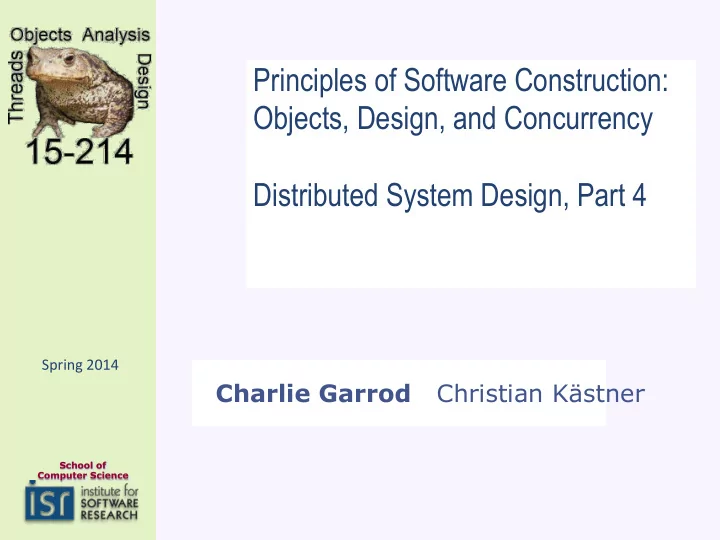

Principles of Software Construction: Objects, Design, and Concurrency Distributed System Design, Part 4 ¡ ¡ ¡ Spring ¡2014 ¡ Charlie Garrod Christian Kästner School of Computer Science
Administrivia • Homework 6, homework 6, homework 6… • Upcoming: § This week: Distributed systems and data consistency § Next week: TBD and guest lecture § Final exam: Monday, May 12 th , 5:30 – 8:30 p.m. UC McConomy § Final exam review session: Saturday, May 10 th , 6 – 8 p.m. PH 100 15-‑214 2
Last time … 15-‑214 3
Today: Distributed system design, part 4 • General distributed systems design § Failure models, assumptions § General principles § Replication and partitioning § Consistent hashing 15-‑214 4
Types of failure behaviors • Fail-stop • Other halting failures • Communication failures § Send/receive omissions § Network partitions § Message corruption • Performance failures § High packet loss rate § Low throughput § High latency • Data corruption • Byzantine failures 15-‑214 5
Common assumptions about failures • Behavior of others is fail-stop (ugh) • Network is reliable (ugh) • Network is semi-reliable but asynchronous • Network is lossy but messages are not corrupt • Network failures are transitive • Failures are independent • Local data is not corrupt • Failures are reliably detectable • Failures are unreliably detectable 15-‑214 6
Some distributed system design goals • The end-to-end principle § When possible, implement functionality at the end nodes (rather than the middle nodes) of a distributed system • The robustness principle § Be strict in what you send, but be liberal in what you accept from others • Protocols • Failure behaviors • Benefit from incremental changes • Be redundant § Data replication § Checks for correctness 15-‑214 7
Replication for scalability: Client-side caching • Architecture before replication: database server: front-end client {alice:90, bob:42, front-end …} client § Problem: Server throughput is too low • Solution: Cache responses at (or near) the client § Cache can respond to repeated read requests database server: cache front-end client {alice:90, bob:42, front-end client cache …} 15-‑214 8
Replication for scalability: Client-side caching • Hierarchical client-side caches: cache client cache client cache database front-end {alice:9 bob:42 front-end …} cache client cache client cache 15-‑214 9
Replication for scalability: Server-side caching • Architecture before replication: database server: front-end client {alice:90, bob:42, front-end …} client § Problem: Database server throughput is too low • Solution: Cache responses on multiple servers § Cache can respond to repeated read requests cache database server: front-end client {alice:90, bob:42, cache front-end client …} cache 15-‑214 10
Cache invalidation • Time-based invalidation (a.k.a. expiration) § Read-any, write-one § Old cache entries automatically discarded § No expiration date needed for read-only data • Update-based invalidation § Read-any, write-all § DB server broadcasts invalidation message to all caches when the DB is updated • What are the advantages and disadvantages of each approach? 15-‑214 11
Cache replacement policies • Problem: caches have finite size • Common* replacement policies § Optimal (Belady's) policy • Discard item not needed for longest time in future § Least Recently Used (LRU) • Track time of previous access, discard item accessed least recently § Least Frequently Used (LFU) • Count # times item is accessed, discard item accessed least frequently § Random • Discard a random item from the cache 15-‑214 12
Partitioning for scalability • Partition data based on some property, put each partition on a different server CMU server: {cohen:9, bob:42, front-end client …} MIT server: front-end client {deb:16, Yale server: reif:40, {alice:90, …} pete:12, …} 15-‑214 13
Horizontal partitioning • a.k.a. "sharding" • A table of data: username school value cohen CMU 9 bob CMU 42 alice Yale 90 pete Yale 12 deb MIT 16 reif MIT 40 15-‑214 14
Recall: Basic hash tables • For n -size hash table, put each item X in the bucket: X.hashCode() % n � 0 {reif:40} 1 2 3 {bob:42} 4 5 {pete:12} {alice:90} 6 7 8 9 10 11 {deb:16} {cohen:9} 12 15-‑214 15
Partitioning with a distributed hash table • Each server stores data for one bucket • To store or retrieve an item, front-end server hashes the key, contacts the server storing that bucket Server 1: Server 0: { } {reif:40} front-end client Server 5: front-end client {pete:12, Server 3: alice:90} {bob:42} … 15-‑214 16
Consistent hashing • Goal: Benefit from incremental changes § Resizing the hash table (i.e., adding or removing a server) should not require moving many objects • E.g., Interpret the range of hash codes as a ring § Each bucket stores data for a range of the ring • Assign each bucket an ID in the range of hash codes • To store item X don't compute X.hashCode() % n . Instead, place X in bucket with the same ID as or next higher ID than X.hashCode() � 15-‑214 17
Problems with hash-based partitioning • Front-ends need to determine server for each bucket § Each front-end stores look-up table? § Master server storing look-up table? § Routing-based approaches? • Places related content on different servers § Consider range queries: SELECT * FROM users WHERE lastname STARTSWITH 'G' � 15-‑214 18
Master/tablet-based systems • Dynamically allocate range-based partitions § Master server maintains tablet-to-server assignments § Tablet servers store actual data § Front-ends cache tablet-to-server assignments Master: Tablet server 1: {a-c:[2], k-z: d-g:[3,4], {pete:12, h-j:[3], reif:42} k-z:[1]} front-end client Tablet server 3: front-end d-g: client Tablet server 2: {deb:16} a-c: h-j:{ } {alice:90, bob:42, Tablet server 4: cohen:9} d-g: {deb:16} 15-‑214 19
Combining approaches • Many of these approaches are orthogonal • E.g., For master/tablet systems: § Masters are often partitioned and replicated § Tablets are replicated § Meta-data frequently cached § Whole master/tablet system can be replicated 15-‑214 20
Thursday • Serializability 15-‑214 21
Recommend
More recommend